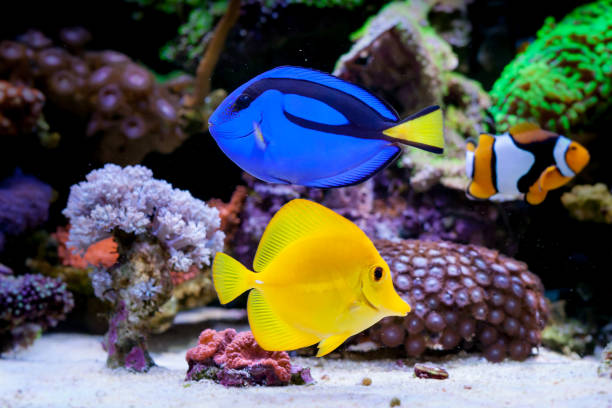Studying the vast wonders of marine life from the comforts of your home is a fascinating experience made possible through the establishment and maintenance of a saltwater aquarium. The intricate but rewarding task of setting up your personal aquatic ecosystem encompasses more than merely adding water and marine creatures into a tank. The success of your aquatic habitat largely relies on understanding the essential aspects of a saltwater aquarium, from the fundamentals of its function and mechanics to the appropriate conditions necessary for marine life. By developing a thorough knowledge of the suitable fish species for your tank, their diverse survival requirements, behaviors, and food preferences, you can create an environment that ensures their longevity and harmonious coexistence. Further, being able to identify genuine suppliers and effectively gauge the health of your potential marine companions can safeguard your investment and maintain the overall health of your marine ecosystem.
Understanding Saltwater Aquarium Basics
Understanding A Saltwater Aquarium
A saltwater aquarium can provide an intriguing piece of living art for your home or office, but setting one up and choosing fish requires an understanding of some basics relating to how the aquarium works and the conditions necessary to support aquatic life.
Filtration Basics
The first aspect to consider is filtration. This is a multi-stage process that includes mechanical, chemical, and biological filtration. Mechanical filtration removes visible matter from the water, like uneaten food or fish waste. Chemical filtration targets invisible pollutants such as chlorine, metals, or odors, while biological filtration uses beneficial bacteria to convert harmful toxins into less harmful substances. For a saltwater aquarium, specialized saltwater filters available in the market are the practical choice.
Lighting Requirements
Next, lighting plays a critical role. The right intensity, duration, and spectrum of light support photosynthesis in plants and corals, maintain the fish’s metabolic cycles, and enhance the colors of your fish and corals. Depending on the occupants of your aquarium, you may need to adjust the lighting conditions. For example, photosynthetic organisms or coral reefs might need high-intensity light, while deep-sea species prefer dimmer environments.
Temperature Control
Temperature control is another aspect to consider. Most saltwater fish live in relatively stable ocean environments, so a consistent temperature is key. A typical range would be between 75-82 degrees Fahrenheit (24-28 degrees Celsius). Using an aquarium heater and chiller can help maintain the desired temperature balance for your saltwater fish.
Marine Substrate
Lastly, choosing the correct marine substrate (bottom material) is also crucial. The substrate can impact the chemistry of your water and provide a natural environment for tank residents. Coral sand, crushed coral or aragonite are popular choices as they help maintain a proper pH balance in the aquarium.
Choosing Fish for Your Saltwater Aquarium
After understanding the basic mechanics of maintaining a saltwater aquarium, selecting the fish is the next big task. You should opt for robust saltwater fish that are known to thrive in aquarium conditions as a beginner. Some of them could be clownfish, damselfish, or tangs.
Remember, creating a balanced ecosystem within an aquarium takes time. It’s essential to add fish incrementally and monitor the water conditions closely after each introduction. Past the initial setup, regular monitoring and maintenance of water quality, light, and temperature will become routine, ensuring a healthy environment for your chosen fish.
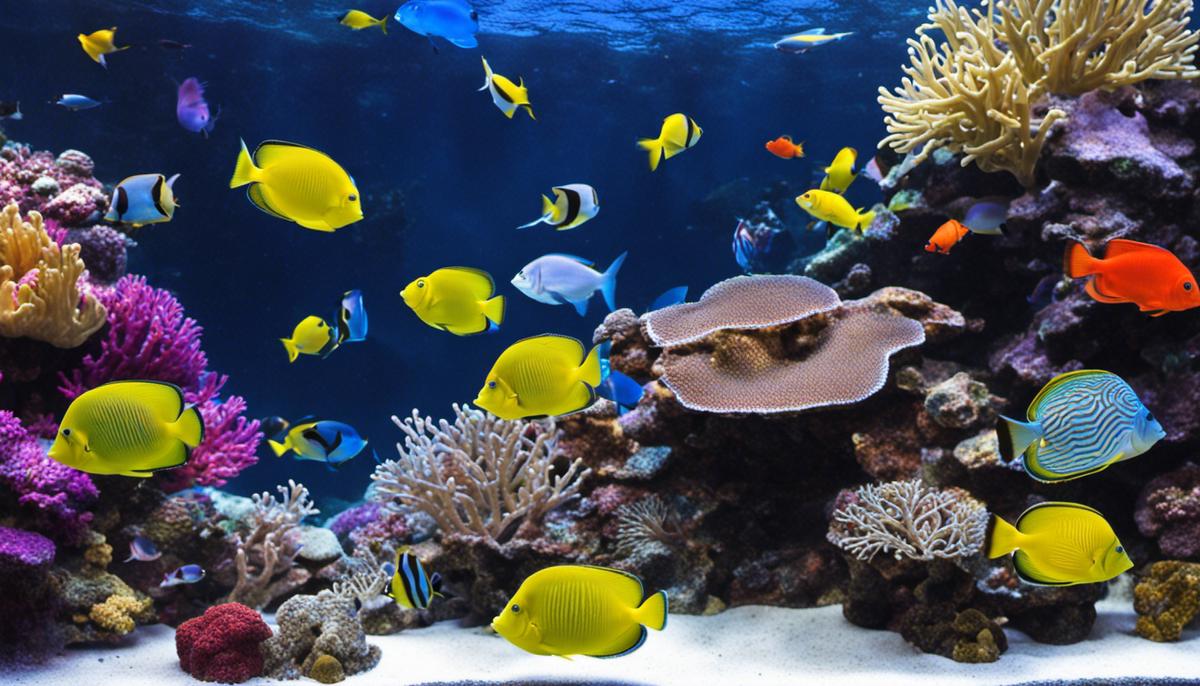
Researching Suitable Fish Species
Understanding Saltwater Fish Species
The primary step in choosing fish for your saltwater aquarium is to understand the different types of fish species suitable for saltwater environments. Fish species such as Clownfish, Damselfish, Angelfish, and Surgeonfish are popular choices for saltwater aquariums due to their hardiness and vibrant colors. Conduct thorough research on each species, looking into their individual requirements and characteristics to make an informed decision.
Survival Requirements of Fish
Each species of saltwater fish comes with its own set of survival requirements. These include water temperature, pH level, salinity, and lighting conditions. Most saltwater fish thrive in temperatures between 72 and 78 degrees Fahrenheit, a pH level of 8.1 to 8.4, and a specific gravity of 1.020 to 1.025. While some fish are more tolerant of minor fluctuations, others require precise conditions to survive. Therefore, understanding and being able to maintain these requirements is crucial in ensuring the health and longevity of the fish in your aquarium.
Assessing Fish Temperament
Fish temperament plays a significant role in the harmony of your aquarium. While some saltwater fish are peaceful and get along well with others, some species are aggressive or territorial. Mixing aggressive fish with peaceful ones can lead to conflicts and harm the well-being of your aquatic community. Thus, it’s essential to select fish that have compatible temperaments.
Considering Fish Size
The size of the fish is another critical factor to consider. Bear in mind the adult size of the fish, not the size it is when you buy it. Some saltwater fish can grow considerably, and an overcrowded tank can lead to stress, disease, and even death among the fish. Therefore, make sure your aquarium has enough space for each fish to grow and move comfortably.
Observing Fish Habits
Fish habits such as feeding, swimming patterns, and whether they are nocturnal or diurnal can affect their compatibility with other species. For example, bottom-dwelling fish may not get along with species that also prefer the tank’s lower levels. Be sure to choose species that complement each other’s habits to avoid territorial disputes and competition for resources.
Analyzing Fish Diet
Finally, investigate the dietary requirements of each fish species. Some fish are herbivores, others are carnivores, and some are omnivores. Knowing the dietary needs of each species can help you provide the right food and ensure the health and happiness of your fish. Certain species may even have specific feeding behaviors and schedules that need to be accommodated.
By taking the time to research these facets of each saltwater fish species, you can curate a diverse, harmonious, and thriving saltwater aquarium. This will not only serve as a stunning centerpiece for your home but also be a rewarding and gratifying hobby.
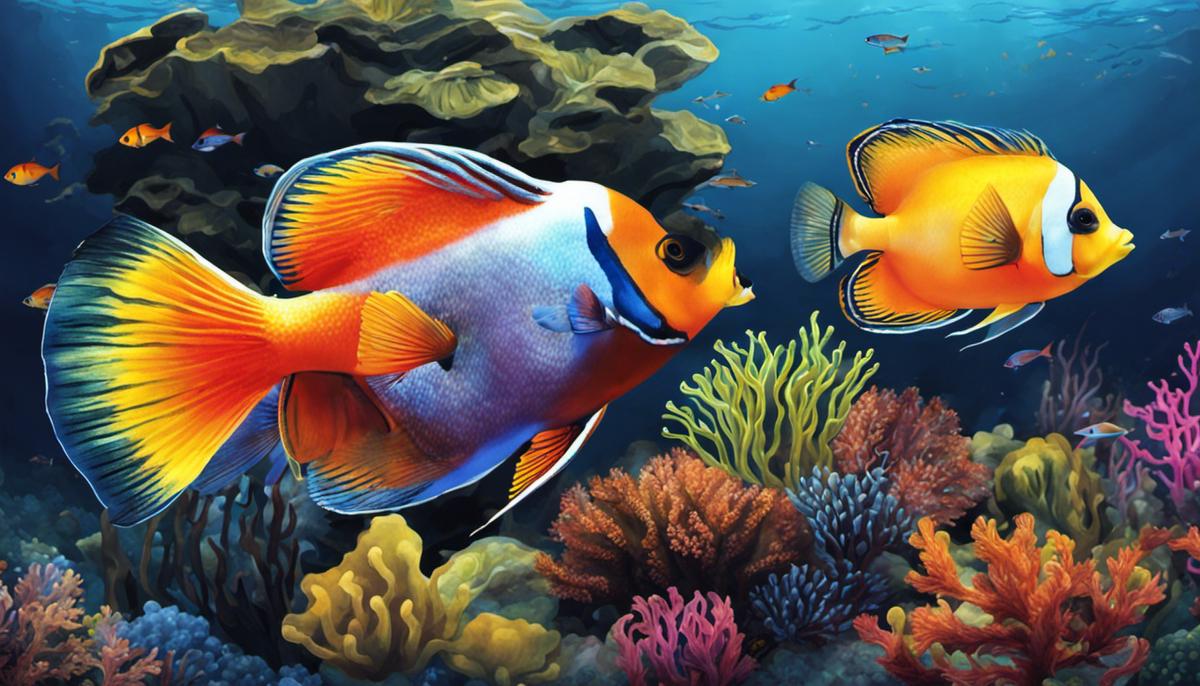
Choosing Suppliers and Inspecting Fish Health
Choosing Reliable Fish Suppliers
When shopping for fish for your saltwater aquarium, begin by identifying reputable suppliers in your area. These could either be brick-and-mortar pet stores or online suppliers. Investigate the seller’s reputation by checking out their customer reviews and ratings on their website, social media, or aquarium enthusiast forums. Find out if they have a solid track record of providing healthy, high-quality fish.
Ensure the supplier offers a wide selection of species suitable for a saltwater aquarium to provide you with various options to choose from. The supplier should also be knowledgeable about their stock. They should be able to answer your questions about the fish, including their breeding conditions, diet requirements, temperaments, and compatibility with other species.
Understanding the Conditions at the Supplier
When visiting the suppliers’ location, inspect the conditions of the store or the quarantine area if you’re dealing with an online supplier. The fish tanks should be clean and well-maintained. Overcrowded or dirty tanks can be a sign of poor fish care and could lead to health problems in the fish.
Actively avoid any supplier that does not practice the quarantine of new arrivals. This is crucial to prevent the spread of diseases and parasites to other fish, which could be a risk you take into your home aquarium.
Inspecting Fish Health Before Purchase
Before you decide to purchase, take time to observe the fish for any signs of illness, stress, or poor health. Healthy fish should show vibrant colors, have clear eyes, and demonstrate active swimming patterns. They should also have a healthy appetite, so request to see feeding time to assess this.
Look out for signs of poor condition such as faded colors, cloudy eyes, visible parasites, spots or unusual growths, split or frayed fins, abnormal swimming patterns, or a lack of appetite. Any of these indicate a potential health issue in the fish.
Check also for signs of stress in the fish, such as rapid breathing, hiding or cowering in corners and shadows, or a lack of interaction with other fish. Prolonged stress can lead to a weakened immune system in fish, making them more susceptible to illnesses.
By investing time in finding the right supplier and carefully inspecting the fish’s health, you’ll increase the likelihood of creating a vibrant, healthy saltwater aquarium environment that you can enjoy for years to come.
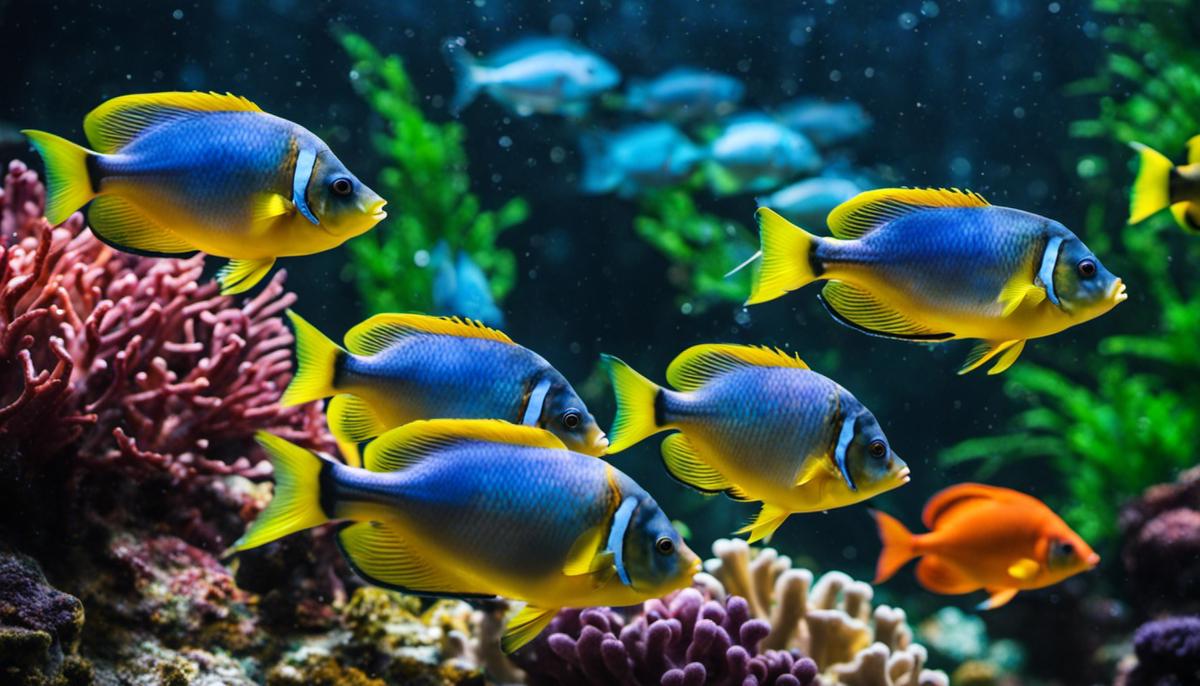
Understanding Tank Compatibility
Understanding The Basics Of Saltwater Aquarium Compatibility
When choosing fish for your saltwater aquarium, a fundamental knowledge of fish species is essential. Not all fish are compatible with each other, and some species may cause stress or danger to others. Researching individual fish species to understand their behavioral patterns, habits, and interactions can help prevent territorial disputes within the tank.
Recognizing Territorial Behaviour
Certain species of fish are territorial by nature and may not cohabitate well with others. These species often establish a “home” or area within the tank that they perceive as their own, and they could become aggressive towards other fish entering this space. Damselfish, for example, are a beautiful but territorial species that could pose a threat to more peaceful fish species when stressed.
Considering Predator-Prey Relationships
One of the vital factors in tank compatibility is recognizing and respecting natural predator-prey relationships that exist in the wild. Grouping predatory fish with smaller species that could be identified as prey would result in a stressful environment for the potential prey. Lionfish and Groupers, for example, are predatory species and should not be paired with smaller, peaceful fish.
The Importance of Fish Size and Growth Rate
Generally, larger fish should not be housed with smaller fish because some large fish species are prone to bully or even eat smaller ones. Additionally, fish that grow faster than their tank mates might outcompete them for food and territory, leading to stress and possible death.
Compatibility Due to Similar Environmental Needs
Matching fish species with similar environmental needs is crucial for a harmonious tank environment. Some species prefer rocky environments, others are happier around plant-filled areas, and others prefer open water. If you mix species with very different requirements, some fish will not have their needs met and may become stressed or unhealthy.
The Role of Diet in Compatibility
Fish with similar diets tend to coexist more peacefully because they do not compete for food. In contrast, species with different dietary needs might fight over food resources, leading to aggression and stress. Do research on each species’ dietary preferences and try to combine species with similar diets and feeding behaviors.
In conclusion
Understanding tank compatibility in saltwater aquariums involves asking questions about many different aspects of a fish’s natural behaviors, diet, and environmental preferences. This kind of careful planning and research can go a long way toward creating a healthy and harmonious environment for all the fish in your tank.
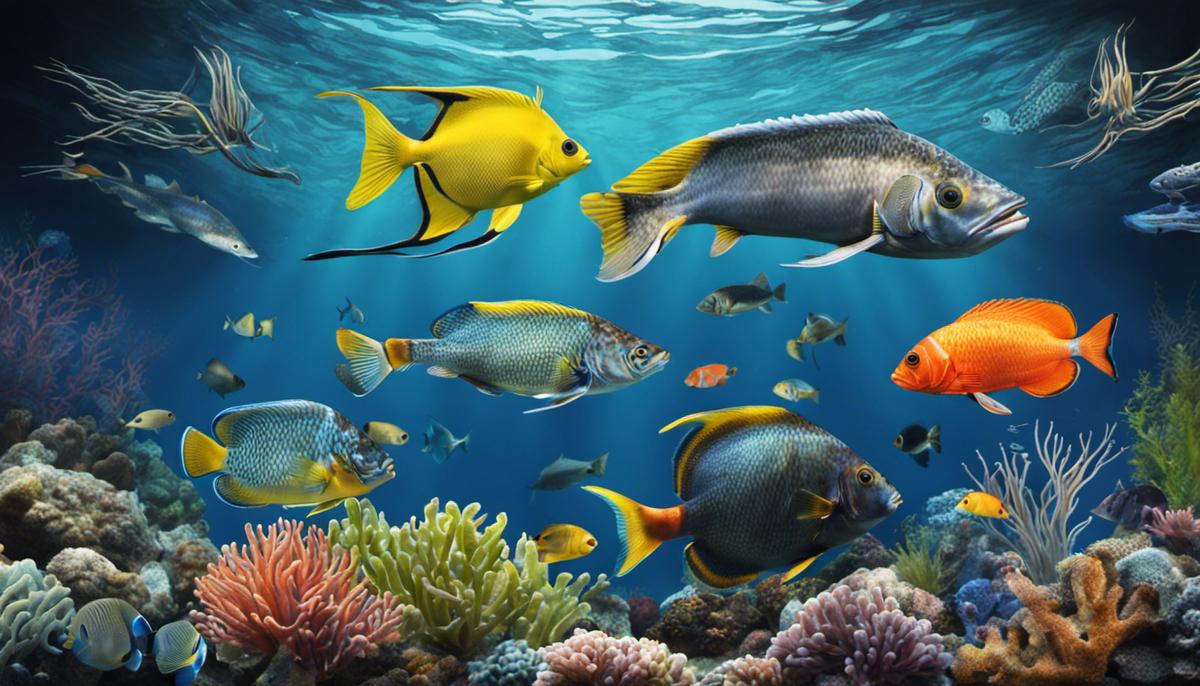
Beyond the beautiful aesthetics, the educational and relaxing benefits that come with setting up and maintaining a saltwater aquarium are unmatched. An expansive knowledge of aquarium basics aids in achieving a thriving aquatic environment. This includes a comprehensive understanding of the suitable fish species, their individual needs, their compatibility with others, and the ability to identify possible health issues. Equipped with this knowledge, you can make informed decisions on which species to include in your marine family and take proactive steps to ensure their well-being. Careful research and meticulous attention to detail are tasks that come with the responsibility of owning a saltwater aquarium. However, the rewarding experience of nurturing a personal underwater ecosystem provides a personal, hands-on education about marine life and the delicate balance of aquatic habitats that neither textbooks nor documentaries can truly capture.
ChasingNemo.com is a participant in the Amazon Services LLC Some of the links in our posts are affiliate links. Click Here For Full Disclosure.

